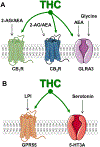THC and CBD: Similarities and differences between siblings
- PMID: 36638804
- PMCID: PMC9898277
- DOI: 10.1016/j.neuron.2022.12.022
THC and CBD: Similarities and differences between siblings
Abstract
Δ9-tetrahydrocannabinol (THC) and its sibling, cannabidiol (CBD), are produced by the same Cannabis plant and have similar chemical structures but differ dramatically in their mechanisms of action and effects on brain functions. Both THC and CBD exhibit promising therapeutic properties; however, impairments and increased incidence of mental health diseases are associated with acute and chronic THC use, respectively, and significant side effects are associated with chronic use of high-dose CBD. This review covers recent molecular and preclinical discoveries concerning the distinct mechanisms of action and bioactivities of THC and CBD and their impact on human behavior and diseases. These discoveries provide a foundation for the development of cannabinoid-based therapeutics for multiple devastating diseases and to assure their safe use in the growing legal market of Cannabis-based products.
Copyright © 2022 Elsevier Inc. All rights reserved.
Conflict of interest statement
Declaration of interests N.S. is employed by the University of Washington, Seattle, and by Stella Consulting, LLC. The terms of this arrangement have been reviewed and approved by the University of Washington in accordance with its policies governing outside work and financial conflicts of interest in research.
Figures










References
-
- National Academies of Sciences, E. & Medicine. The health effects of cannabis and cannabinoids: the current state of evidence and recommendations for research. (2017). - PubMed
Publication types
MeSH terms
Substances
Grants and funding
LinkOut - more resources
Full Text Sources
Other Literature Sources

